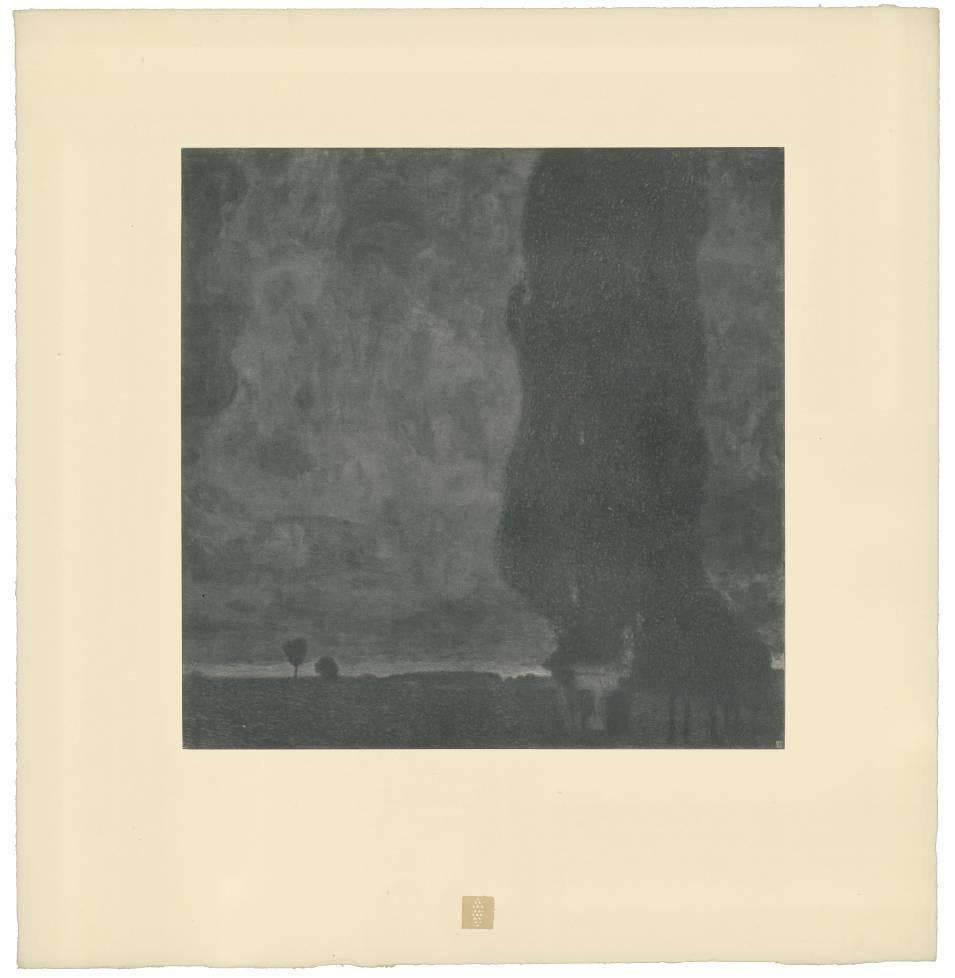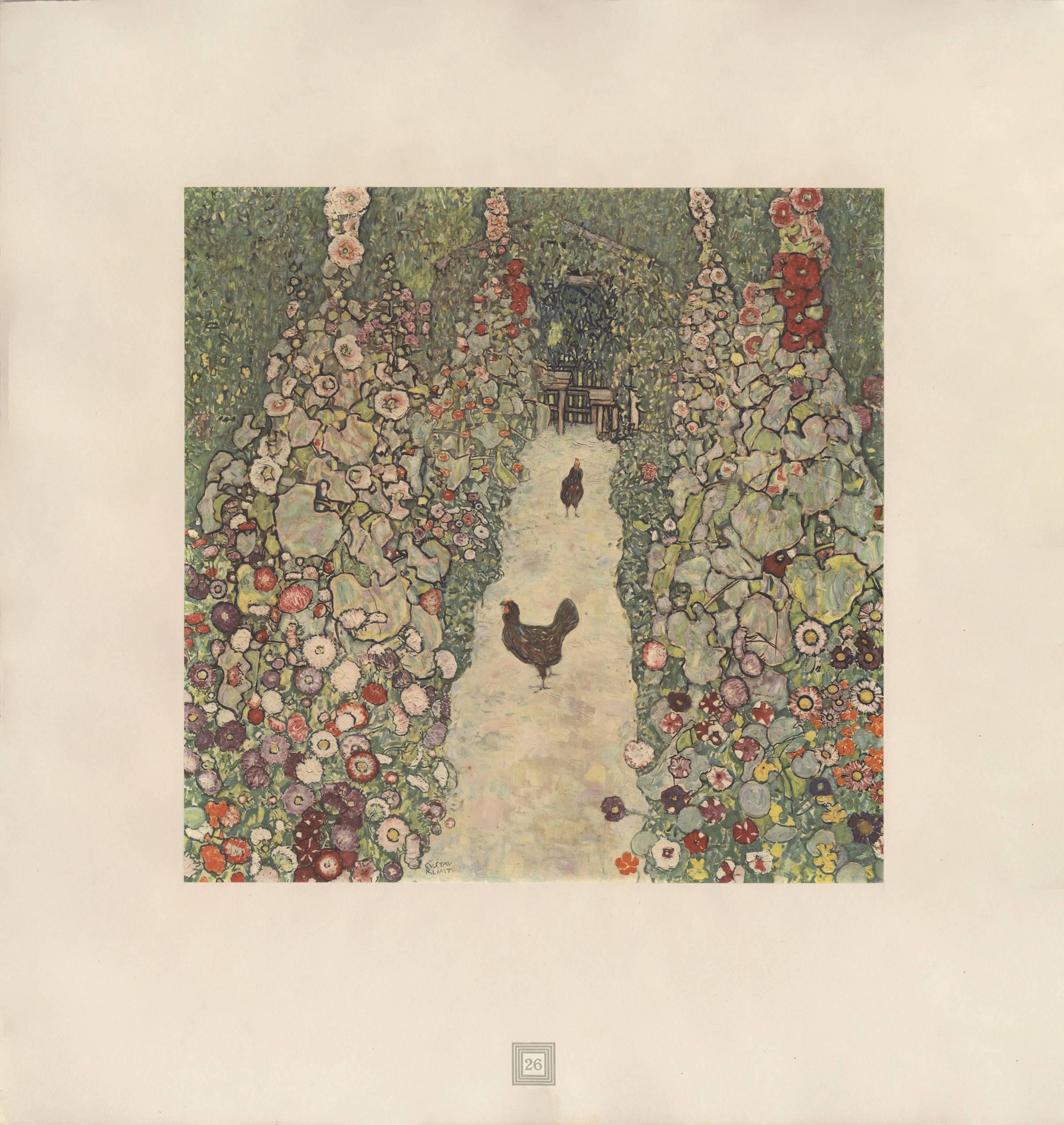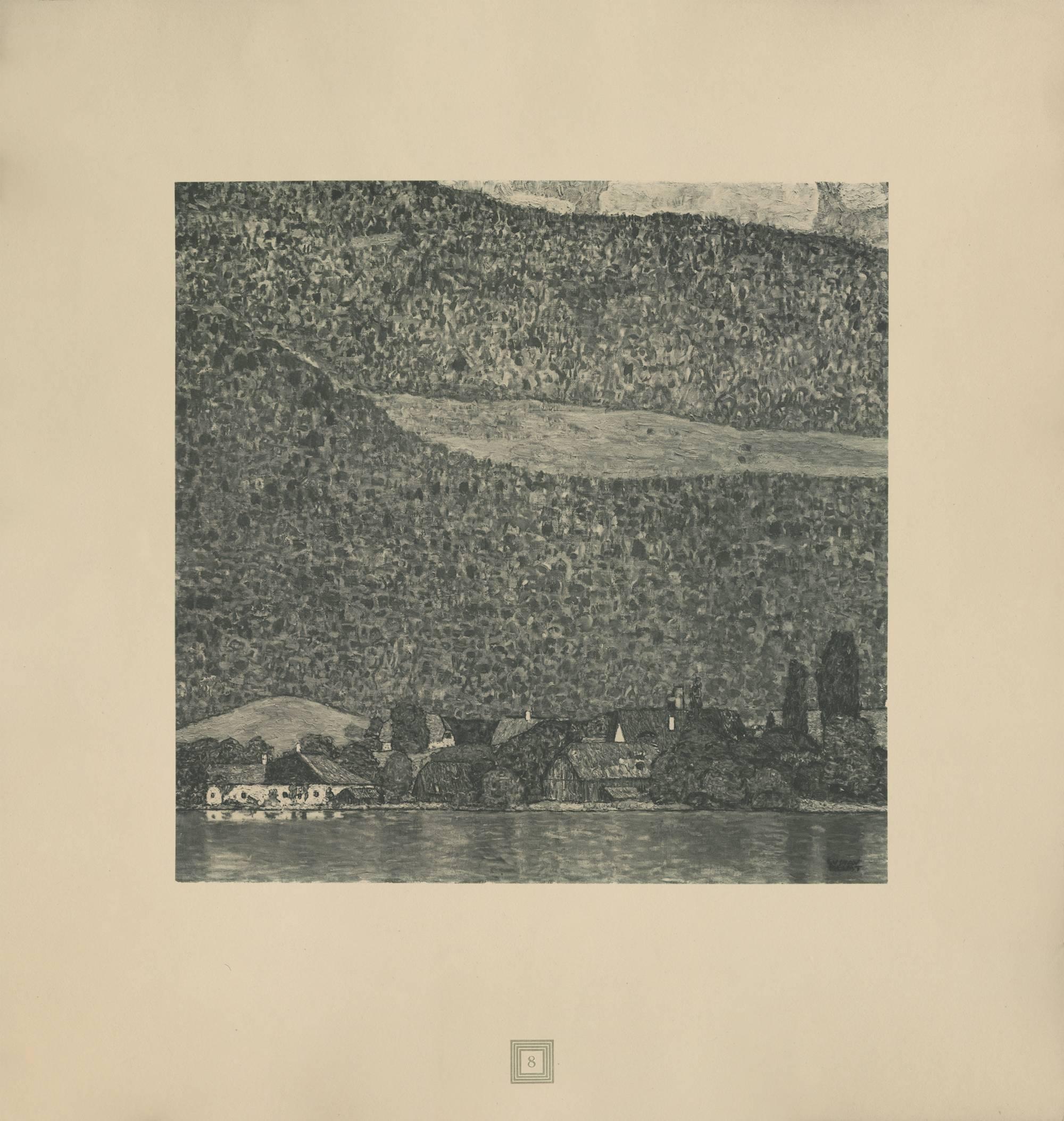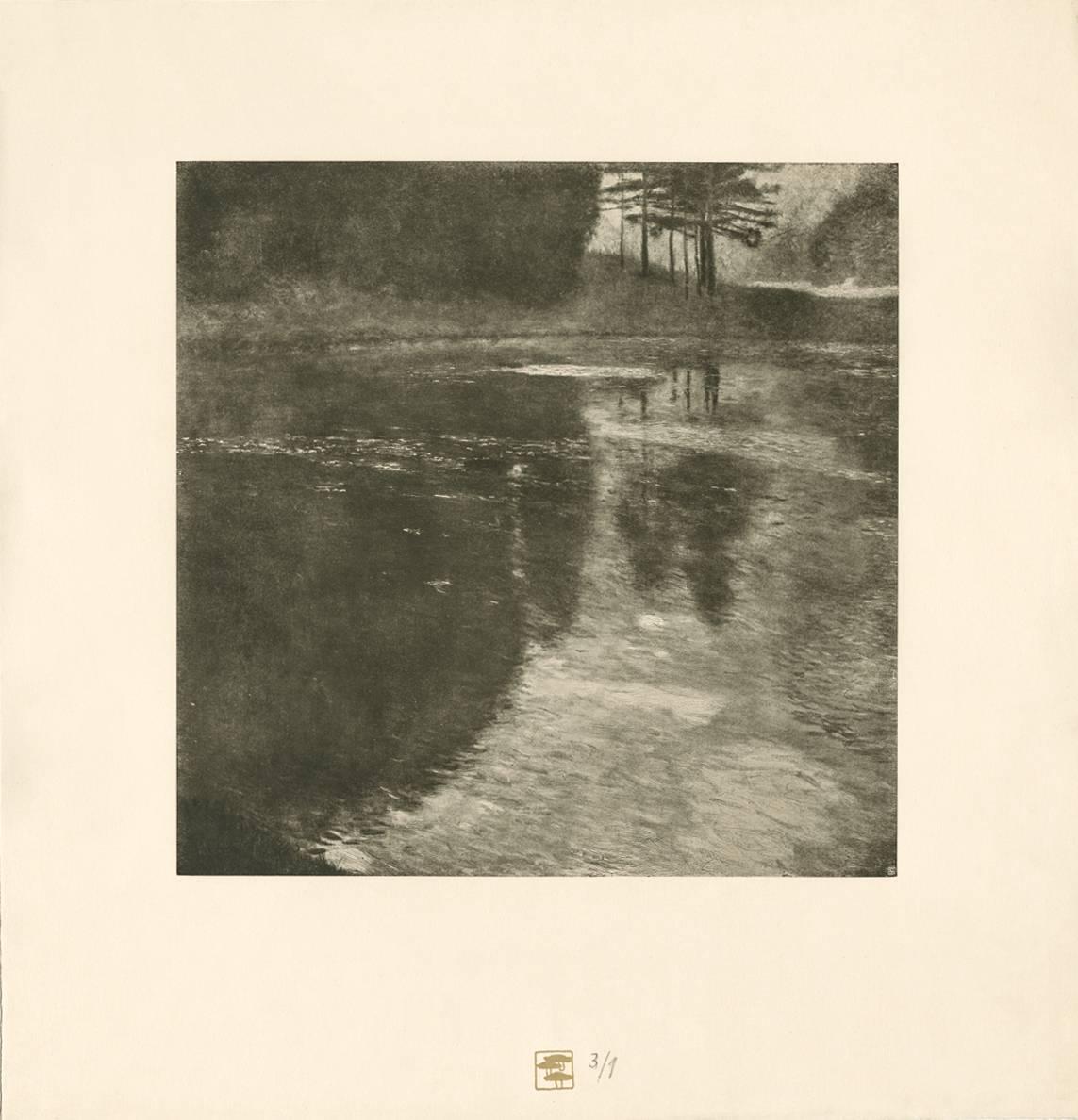Items Similar to H.O. Miethke Das Werk folio "Birch Forest I" collotype print
Want more images or videos?
Request additional images or videos from the seller
1 of 5
Gustav Klimt & K.K. Hof-und StaatsdruckereiH.O. Miethke Das Werk folio "Birch Forest I" collotype print1908-1914
1908-1914
About the Item
DAS WERK GUSTAV KLIMTS, a portfolio of 50 prints, ten of which are multicolor collotypes on chine colle paper laid down on hand-made heavy cream wove paper with deckled edges; under each of the 50 prints is a gold signet intaglio printed on the cream paper each of which Klimt designed for the publication as unique and relating to its corresponding image; H.O. Miethke, Editor-Publisher; k.k. Hof-und Staatsdruckerei, Printer; printed in a limited edition of 300 numbered plus several presentation copies; Vienna, 1908-1914.
The idea of collaboration in the arts is anything but new; however it has so often been viewed and assessed as somehow devaluing the intrinsic worth of art. It’s as if it was a dirty secret to be hidden away. More so even than the eroticism explored by Klimt, which divided public opinion, the artistic avant-garde began to boldly flaunt artistic collaboration beginning in the 19th century- which gained steam in the first part of the 20th century- to become a driving vehicle of contemporary artistic creation. Viewed in this context, the folios of collotype prints published by H.O. Miethke in Vienna between 1908-1914 known as Das Werk Gustav Klimts, are important art documents worthy of as much consideration for their bold stand they take on established ways of thinking about artistic collaboration as they are for their breathtakingly striking images.
1908 is indeed a watershed moment in the history of art. To coincide with the 60th anniversary of the reign of Emperor Franz Joseph I, Kunstschau opened in Vienna in May of that year. It was there that Klimt delivered the inaugural speech. Speaking about the avant-garde group’s unifying philosophy of Gesamtkunstwerk, or the synthesis of the arts, Klimt shared his belief that the ideal means to bring artists and an audience together was via “work on major art projects.” It was at Kunstschau 1908 that Klimt first exhibited his most iconic painting, The Kiss, as well as The Sunflower, Water Snakes I and II and Danae. It was at Kunstschau 1908 that Das Werk Gustav Klimts was first available for purchase. Thanks to Galerie Miethke’s organization, Kunstschau 1908 was possible. Miethke’s pioneering art house had become Klimt’s exclusive art dealer and main promoter of his modernist vision. Paul Bacher and Carl Moll, a founding member with Klimt of the Vienna Secession, who all broke away during the rift in 1905, took stewardship of the gallery following the fallout with the Secession. Das Werk Gustav Klimts is a prime example of Miethke’s masterful and revolutionary approach to marketing art. Miethke’s innovative marketing strategy played to a penchant for exclusivity. The art gallery and publishing house utilized the press and art critics- such as Austria’s preeminent Art Historian, Hugo Haberfield, who became Director of the gallery in 1912- as a means of gaining publicity as well as maintaining effective public relations. Miethke used the grand exposition format to extend the art gallery’s market reach, cultivating their product’s prestige by stroking the egos of current art patrons while simultaneously creating accessibility for newcomers and others avid collectors to share a relative proximity to other wealthy and respected members of the art collecting community. Essentially, their approach paved the way for what is still the predominant means of marketing.
Between 1908 and 1914, H.O. Miethke published a total of 5 installments of print folios of Klimt’s painted work, each comprising 10 prints. The series was limited in availability to 300 and purchase was arranged through subscription. Each issue was presented unbound in a gold embossed black paper folder. Included in the folio was a Title Page, a Justification page and a Table of Contents page itemizing each of the 10 printed works with details about their corresponding painted works as well as information about each work’s current owner. These folios were not comprehensive of Klimt’s work; but rather, they feature what he believed were his most important paintings from 1898-1913. Only 2 collotypes in each folio were multicolored.
To punctuate the fact that Klimt, himself, was very much an active player in creating these printed works, he created square-shaped signets, unique to each collotype which were intaglio printed in gold ink at the bottom of the cream wove papers to which the chine collie papers were affixed.These signets relate thematically to their corresponding printed images and designate each of those images by their placement in the folio’s Table of Contents page. Functioning much more than simply decorative motifs, these individualized signets provide a distillation of the printed works’s analogous theme. Alice Strobl’s scholarship on this subject confirms Klimt’s involvement throughout the 7-year production process. The Virgin, for example, which dates from c. 1912-1913, was created well after the portfolio was first conceived c. 1908. Its corresponding signet, therefore, could not have been created a priori.
Art Historians, such as Strobl, have shed much light upon the ongoing and collaborative nature of the Das Werk endeavor. Understanding the fragile nature of the collotype printing process also reinforces this project’s distinctive and ground-breaking characteristics. The fragile collotype plates could not be reused. As such, this necessitated the completion of a run on the first go and also dictated the limited production numbers such as the 300 pulled for Klimt’s Das Werk. Printed by hand, the collotypes required deft handling by the printer, k.k..Hof-und Staatsdruckerei. A complicated and lengthy process involving gelatin colloids mixed with dichromates, the creation of 16 color separation thin glass filters to achieve the light-sensitive internegative images which could faithfully capture all of the painting’s tonal gradations and colors, exposure to actinic light, and delicate chine collie papers which allowed for greater color saturation, the printer’s collaborative role in capturing and transmitting Klimt’s nuanced paint strokes is nothing short of remarkable. Ernst Ganglbauer, Director of kaiserlich-konigliche Hof-und Staatsdruckerei (1901-1917) was eager to promote art prints. An innovator, he elevated the Kaiser’s press to international renown by assembling the best of the best in technical and aesthetic advisors. This dream team of free-lance artists developed adaptive uses for the Staatsdruckerei’s existing equipment and, together with the printers there, perfected the multicolor print process for Miethke and Klimt’s Das Werk.
These multicolored collotype prints are perfect examples of what Klimt referred to as “major art projects.” By their very nature, the print medium, these works could bring artists and audience together in a highly accessible way. Each step in the process of their creation required a high level of technical expertise, innovative thinking and true artistic collaboration, Gesamtkunstwerk. The Emperor, himself, was the first to subscribe. His support was firm recognition that Das Werk Gustav Klimts was indeed a masterpiece and product of a dream team enterprise. In the seven-year span that this elite team of talented artists and innovative thinkers produced the complete collection, the Kaiser’s world had radically changed. In just a few years, world war would close with the deaths of Klimt, Miethke, the Austro-Hungarian Empire, marking an end to a fruitful artistic era.
- Creator:Gustav Klimt & K.K. Hof-und Staatsdruckerei (1862 - 1918, Austrian)
- Creation Year:1908-1914
- Dimensions:Height: 18 in (45.72 cm)Width: 18.5 in (46.99 cm)
- Medium:
- Movement & Style:
- Period:
- Condition:
- Gallery Location:Chicago, IL
- Reference Number:1stDibs: LU46739768692

About the Seller
5.0
Gold Seller
These expertly vetted sellers are highly rated and consistently exceed customer expectations.
Established in 2013
1stDibs seller since 2016
82 sales on 1stDibs
Typical response time: 2 hours
- ShippingRetrieving quote...Ships From: Chicago, IL
- Return PolicyA return for this item may be initiated within 3 days of delivery.
More From This SellerView All
- H.O. Miethke Das Werk folio "The Great Poplar II (Thunderstorm)" collotype printBy Gustav Klimt & K.K. Hof-und StaatsdruckereiLocated in Chicago, ILDAS WERK GUSTAV KLIMTS, a portfolio of 50 prints, ten of which are multicolor collotypes on chine colle paper laid down on hand-made heavy cream wove paper with deckled edges; under ...Category
Early 1900s Vienna Secession Landscape Prints
MaterialsPaper
- Max Eisler Eine Nachlese folio "Litzlberg on Lake Attersee" collotypeBy (after) Gustav KlimtLocated in Chicago, ILAfter Gustav Klimt, Max Eisler Plate #8, Litzlberg on Lake Attersee; blue monochrome collotype after the 1915 painting in oil on canvas. GUSTAV KLIMT EINE NACHLESE (GUSTAV KLIMT AN ...Category
1930s Vienna Secession Landscape Prints
MaterialsPaper
- Max Eisler Eine Nachlese folio “Garden Path with Chickens” collotype printBy (after) Gustav KlimtLocated in Chicago, ILAfter Gustav Klimt, Max Eisler #26, Bauerngarten mit Hühnern; multi-color collotype after 1916 painting in oil on canvas. The original was destroyed by fire in May 1945 at Immendorf Castle, Lower Austria. Landscapes, for Klimt, are vehicles to convey universal themes such as procreation and the mysteries of life. Using a highly personal language of symbols, Klimt creates a voluptuous scene of fertility, fecundity and domesticity. Klimt uses a similarly lustrous palette of pearly iridescence for the path as he had for many of his female nudes. This feminine quality is intensified by the tunnel-effect produced by the walls of colorful floral blooms whose leafy stalks are redolent with wild abundance at the height of summer.The passage leads to a green covered arbor, womb-like, which contains a simple wooden table and a bench. Human presence is unmistakeable.The two chickens shown in the path provide the link to engage with this scene cerebrally and emotionally. Protective and maternal, the mother hens do somewhat bar one’s path, but by no means in a menacing way. The experiential aspect of walking forward and ignoring those chickens, certain that they will dodge out of the way, heightens the rational with the intuitive senses creating the illusion and feeling that the flanking floral walls are parting to provide clear passage to within. Seen in this context, the age old conundrum to divine what came first, the chicken or the egg, begs the question of the greatest mystery of all. One’s relationship to procreation itself, Klimt shows us, is interwoven all around us. Far from banal, this universal quality of the natural world is fraught with thrilling wonder. GUSTAV KLIMT EINE NACHLESE (GUSTAV KLIMT AN AFTERMATH), a portfolio of 30 collotypes prints, 15 are multi-color and 15 are monochrome, on chine colle paper laid down on heavy cream-wove paper with deckled edges; Max Eisler, Editor-Publisher; Osterreichischer Staatsdruckerei (Austrian State Printing Office), Printer; in a limited edition of 500 numbered examples of which: 200 were printed in German, 150 were printed in French and 150 were printed in English; Vienna, 1931. 2018 marks the 100th anniversary of Gustav Klimt’s death. It is a fitting time to reflect upon the enduring legacy and deep impact of his art. Recognizing this need for posterity with uncanny foresight, the publication of Gustav Klimt: An Aftermath (Eine Nachlese) provides a rare collection of work after Klimt which has proven to be an indispensable tool for Klimt scholarship as well as a source for pure visual delight. Approximately 25 percent of the original works featured in the Aftermath portfolio have since been lost. Of those 30, six were destroyed by fire on 8 May 1945. On that fateful final day of WWII, the retreating Feldherrnhalle, a tank division of the German Army, set fire to the Schloss Immendorf which was a 16th century castle in Lower Austria used between 1942-1945 to store objects of art. All three of Klimt’s Faculty Paintings: Philosophy, Medicine and Jurisprudence (1900-1907), originally created for the University of Vienna, were on premises at that time. Also among the inventory of Klimt paintings in storage there was art which had been confiscated by the Nazis. One of the most significant confiscated collections was the Lederer collection which featured many works by Gustav Klimt such as Girlfriends II and Garden Path with Chickens...Category
1930s Vienna Secession Landscape Prints
MaterialsPaper
- H.O. Miethke Das Werk folio "The Great Poplar I" collotype printBy Gustav Klimt & K.K. Hof-und StaatsdruckereiLocated in Chicago, ILDAS WERK GUSTAV KLIMTS, a portfolio of 50 prints, ten of which are multicolor collotypes on chine colle paper laid down on hand-made heavy cream wove paper with deckled edges; under ...Category
Early 1900s Vienna Secession Landscape Prints
MaterialsPaper
- Max Eisler Eine Nachlese folio “Malcesine on Lake Garda" collotype printBy (after) Gustav KlimtLocated in Chicago, ILAfter Gustav Klimt, Max Eisler #7, Malcesine am Gardasee; multi-color collotype after 1913 painting in oil on canvas. The original was destroyed by fire ...Category
1930s Vienna Secession Landscape Prints
MaterialsPaper
- H.O. Miethke Das Werk folio "Pond in the Morning" collotype printBy Gustav Klimt & K.K. Hof-und StaatsdruckereiLocated in Chicago, ILDAS WERK GUSTAV KLIMTS, a portfolio of 50 prints, ten of which are multicolor collotypes on chine colle paper laid down on hand-made heavy cream wove paper with deckled edges; under ...Category
Early 1900s Vienna Secession Landscape Prints
MaterialsPaper
You May Also Like
- Slowakisches Bauernhaus,By Karl SchwetzLocated in New York, NYSchweiz, Karl. Slowakisches Bauernhaus, Ca 1911. Color linoleum cut. Framed. Provenance: Galerie Michael Pabst, Munich. Noted artist, painter, illustr...Category
1910s Vienna Secession Landscape Prints
MaterialsLinocut
- Elia Shiwoohamba ( Namibia, 1981 ) Harvesting Time Lino Cut African School 2006By Elia ShiwoohamaLocated in Meinisberg, CHElia Shiwoohamba (* 1981 , Windhoek, Namibia ) Harvesting Time • African School • Linoleum cut • Sheet ca. 34.5 x 43 cm (Image is smaller) • Bottom left numbered 8/50 and titled • ...Category
Early 2000s Expressionist Landscape Prints
MaterialsPaper, Linocut, Woodcut
- Ghosts of New York 5, mysterious, monochromatic cityscapeBy Tom BennettLocated in Brooklyn, NYOne of a series of oil based monotypes on fine printmaking paper, subtle color design, symbolic and atmospheric figure/figures in cityscapeCategory
2010s Expressionist Landscape Prints
MaterialsMonotype, Archival Paper
- Paul Klee Etching "Felsgräber"By (after) Paul KleeLocated in Berlin, DEHelio-etching on hand-made paper, 1929 by Paul Klee. Signatur is printed, lower center: Klee From portfolio Paul Klee, Handzeichnungen 1921-1930; Here no 50 Image: 4.72 x 7.56 in ( 1...Category
Early 20th Century Expressionist Landscape Prints
MaterialsPaper, Etching
- Paul Klee Etching "Hügelland von Porquerolles"By (after) Paul KleeLocated in Berlin, DEHelio-etching on hand-made paper, 1927 by Paul Klee. Signatur is printed, lower right: Klee From portfolio Paul Klee, Handzeichnungen 1921-1930; Here no 39 Image: 5,0 x 7.6 in ( 12,7...Category
Early 20th Century Expressionist Landscape Prints
MaterialsPaper, Etching
- The Norfolk Broads by Kate Heiss, Limited edition print, Landscape, WildlifeBy Kate HeissLocated in Deddington, GBThe Norfolk Broads [2022] limited_edition and hand signed by the artist Oil based inks on 300GSM Somerset Velvet Paper Edition number 15 Image size:...Category
21st Century and Contemporary Expressionist Landscape Prints
MaterialsPaper, Ink, Mixed Media
Recently Viewed
View AllMore Ways To Browse
H And I
H Reach
Antique Paper Embosser
Water Snake
Painting After Gustav Klimt
Joseph Presser
Sunflower Print
Grand View Tables
Antique Shed
Antique Sheds
1898 Art In Vienna
Embossed Decorative Plate
Folio 10
Revolutionary War Antique
Antique Printing Press
Antique Printing Presses
Printing Press Antique
Sunflower Table





